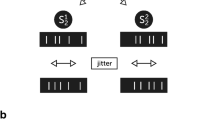Abstract
Pyramidal neurons in layer 5 of the neocortex of the brain extend their axons and dendrites into all layers. They are also unusual in having both an axonal and a dendritic zone for the initiation of action potentials1,2,3,4,5,6. Distal dendritic inputs, which normally appear greatly attenuated at the axon, must cross a high threshold at the dendritic initiation zone to evoke calcium action potentials1,7 but can then generate bursts of axonal action potentials. Here we show that a single back-propagating sodium action potential generated in the axon8 facilitates the initiation of these calcium action potentials when it coincides with distal dendritic input within a time window of several milliseconds. Inhibitory dendritic input can selectively block the initiation of dendritic calcium action potentials, preventing bursts of axonal action potentials. Thus, excitatory and inhibitory postsynaptic potentials arising in the distal dendrites can exert significantly greater control over action potential initiation in the axon than would be expected from their electrotonically isolated locations. The coincidence of a single back-propagating action potential with a subthreshold distal excitatory postsynaptic potential to evoke a burst of axonal action potentials represents a new mechanism by which the main cortical output neurons can associate inputs arriving at different cortical layers.




Similar content being viewed by others
References
Schiller, J., Schiller, Y., Stuart G. & Sakmann, B. Calcium action potentials restricted to the distal apical dendrites of rat neocortical pyramidal neurons. J. Physiol. 505, 605–616 (1997).
Spencer, W. A. & Kandel, E. R. Electrophysiology of hippocampal neurons IV. Fast prepotentials. J. Neurophys. 24, 272–295 (1961).
Magee, J., Hoffman, D., Colbert, C. & Johnston, D. Electrical and calcium signaling in dendrites of hippocampal pyramidal neurons. Annu. Rev. Physiol. 60, 327–346 (1998).
Kim, H. G. & Connors, B. W. Apical dendrites of the neocortex: correlation between sodium- and calcium-dependent spiking and pyramidal cell morphology. J. Neurosci. 13, 5301–5311 (1993).
Hirsch, J. A., Alonso, J. M. & Reid, C. R. Visually evoked calcium action potentials in cat striate cortex. Nature 378, 612–616 (1995).
Rhodes, P. A. Functional Implications of Active Currents in the Dendrites of Pyramidal Neuronsin Cerebral Cortex(eds Ulinski, P. & Jones, E. G.) Vol. 13, 139–200 (Plenum, New York, (1999).
Zhu, J. J. & Sakmann, B. Postnatal development of Ca2+-mediated action potentials in dendritic tufts of rat neocortical pyramidal neurons. Soc. Neurosci. Abstr. 23, 2283 (1997).
Stuart, G. & Sakmann, B. Active propagation of somatic action potentials into neocortical pyramidal cell dendrites. Nature 367, 69–72 (1994).
Markram, H., Helm, P. J. & Sakmann, B. Dendritic calcium transients evoked by single back-propagating action potentials in rat neocortical pyramidal neurons. J. Physiol (Lond.) 485, 1–20 (1995).
Connors, B. W. & Gutnick, M. J. Intrinsic firing patterns of diverse neocortical neurons. Trends Neurosci. 13, 99–104 (1990).
Miles, R., Toth, K., Gulyas, A. I., Hajos, N. & Freund, T. F. Differences between somatic and dendritic inhibition in the hippocampus. Neuron 16, 815–823 (1996).
Buzsáki, G., Penttonen, M., Nádasdy, Z. & Bragin, A. Pattern and inhibition-dependent invasion of pyramidal cell dendrites by fast spikes in the hippocampus in vivo. Proc. Natl Acad. Sci. USA 93, 9921–9925 (1996).
Tsubokawa, H. & Ross, W. N. IPSPs modulate spike backpropagation and associated [Ca2+]i changes in the dendrites of hippocampal CA1 pyramidal neurons. J. Neurophys. 76, 2896–906 (1996).
Chen, H. & Lambert, N. A. Inhibition of dendritic calcium influx by activation of G-protein-coupled receptors in the hippocampus. J. Neurophysiol. 78, 3484–3488 (1997).
Singer, W. & Gray, C. M. Visual feature integration and the temporal correlation hypothesis. Annu. Rev. Neurosci. 18, 555–586 (1995).
Llinás, R., Ribary, U., Joliot, M. & Wang, X. -J. in Temporal Coding in the Brain(eds Buzsáki, G. et al.) 251–272 (Springer, Berlin, (1994).
Heilman, K. M. & Valenstein, E. Clinical Neuropsycology(Oxford Univ. Press, New York, (1993).
Cauller, L. J. & Kulics, A. T. The neural basis of the behaviorally relevant N1 component of the somatosensory-evoked potential in SI cortex of awake monkeys: evidence that backward cortical projections signal conscious touch sensation. Exp. Brain Res. 84, 607–618 (1991).
Zhu, J. J. & Sakmann, B. Whisker-evoked slow oscillation (7–12 Hz) in single neurons of the rat barrel cortex. Soc. Neurosci. Abstr. 24, 1512 (1998).
Zhu, J. J. & Connors, B. W. Intrinsic firing patterns and whisker-evoked synaptic responses of neurons in the rat barrel cortex. J. Neurophysiol. 81, 1171–1183 (1999).
Lisman, J. E. Bursts as a unit of neural information: making unreliable synapses reliable. Trends Neurosci. 20, 38–43 (1997).
Dodt, H. U. Infrared-interference videomicroscopy of living brain slices. Adv. Exp. Med. Biol. 333, 245–249 (1993).
Acknowledgements
We thank B. Katz, A. Korngreen, G. Borst and A. Silver for their helpful comments. M.E.L. was supported by an Alexander von Humboldt scholarship and J.J.Z. was supported by a Max-Planck Gesellschaft fellowship.
Author information
Authors and Affiliations
Rights and permissions
About this article
Cite this article
Larkum, M., Zhu, J. & Sakmann, B. A new cellular mechanism for coupling inputs arriving at different cortical layers. Nature 398, 338–341 (1999). https://doi.org/10.1038/18686
Received:
Accepted:
Issue Date:
DOI: https://doi.org/10.1038/18686
- Springer Nature Limited
This article is cited by
-
How the brain’s primary processing units compute to give rise to intelligence
Nature Reviews Neuroscience (2024)
-
Omission responses in local field potentials in rat auditory cortex
BMC Biology (2023)
-
Neuronal connected burst cascades bridge macroscale adaptive signatures across arousal states
Nature Communications (2023)
-
Cortico-cortical feedback engages active dendrites in visual cortex
Nature (2023)
-
Dendritic excitability controls overdispersion
Nature Computational Science (2023)





